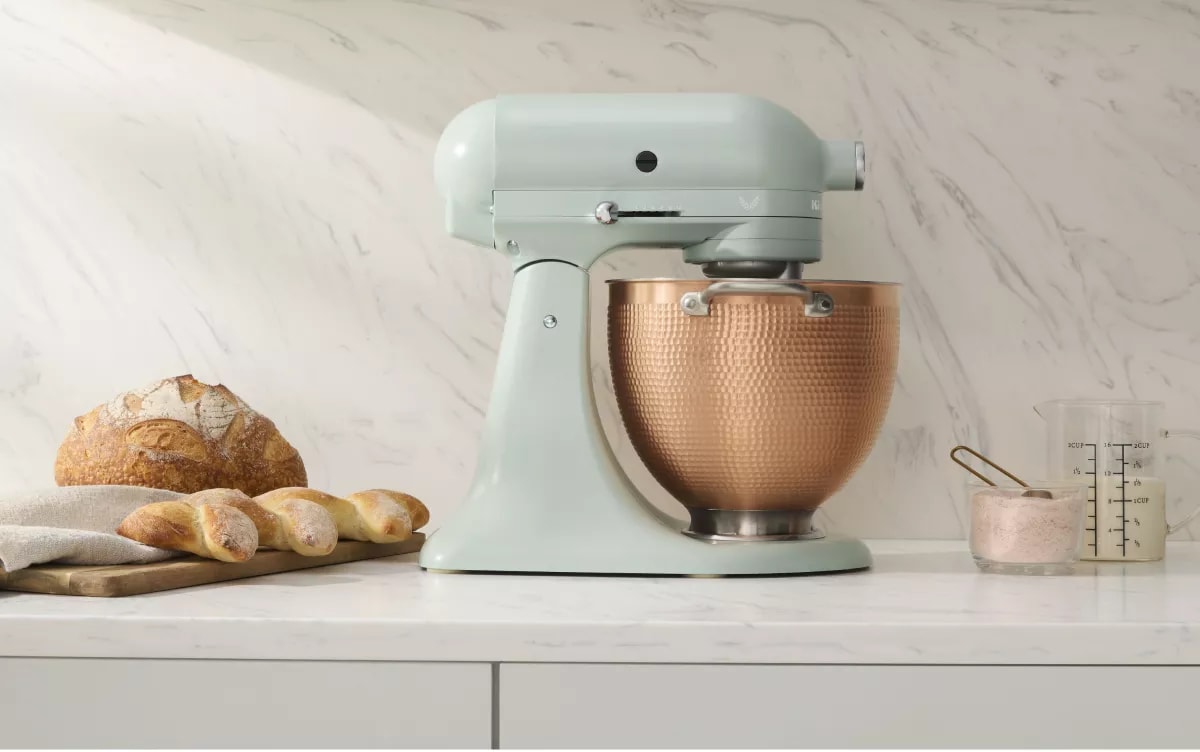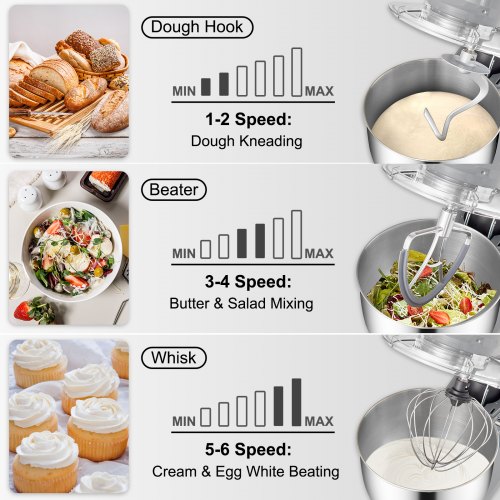Ever wondered what the perfect speed is for kneading bread in your stand mixer? You’re not alone.
Many home bakers face this exact challenge. Getting it just right can be the difference between a loaf that’s fluffy and one that’s dense. Imagine the satisfaction of slicing into a perfectly risen bread, its aroma filling your kitchen. That’s the power of choosing the right speed.
You’ll discover the ideal speed setting for kneading bread dough, ensuring your homemade creations are nothing short of bakery-worthy. Ready to elevate your bread-making game? Let’s dive in and unlock the secrets to perfect kneading with your stand mixer.

Credit: www.walmart.com
Choosing The Right Mixer Speed
Kneading bread dough in a stand mixer needs the right speed. Too slow or too fast can change the dough’s texture. Using the proper speed helps develop gluten and makes kneading easier.
This guide explains what to expect from low, medium, and high mixer speeds. Each speed has its own role in the kneading process.
Low Speed Benefits
Low speed gives gentle kneading. It helps mix ingredients without splashing flour everywhere. It also prevents the dough from heating up too fast, which can affect yeast.
- Mixes ingredients evenly
- Prevents flour dust clouds
- Keeps dough cool and smooth
- Good for initial mixing
Medium Speed Uses
Medium speed is best for kneading most bread doughs. It develops gluten well and forms a nice dough ball. This speed balances power and control.
| Speed Level | Purpose | Effect on Dough |
| Low | Mixing ingredients | Gentle mixing, keeps dough cool |
| Medium | Kneading dough | Good gluten development, smooth dough |
| High | Fast kneading (not recommended) | Can overheat dough, damage gluten |
High Speed Cautions
High speed may seem faster but can harm the dough. It heats the dough too much and breaks gluten strands. This makes bread dense and tough.
- Overheats dough quickly
- Breaks gluten structure
- Makes dough hard to shape
- Not ideal for most bread types
Impact Of Speed On Dough Texture
The speed you use to knead bread dough in a stand mixer affects the dough’s texture. Different speeds change how the dough feels and behaves.
Understanding the right speed helps you get better bread with the texture you want.
Gluten Development
Kneading dough at the correct speed helps gluten strands form properly. Gluten gives bread its structure and chewiness.
Slow speeds may not develop enough gluten, making the bread crumbly. High speeds can overwork gluten, causing the dough to become tough.
- Use medium speed for balanced gluten development
- Too slow means weak structure
- Too fast can tear gluten strands
Dough Temperature
Kneading speed affects the dough’s temperature. Mixing too fast creates heat from friction.
High dough temperature can change yeast activity and fermentation. This alters bread rise and flavor.
- Lower speed keeps dough cooler
- Faster speed raises dough temperature
- Ideal dough temperature is about 75°F (24°C)
Mixing Time And Consistency
Speed affects how long you need to knead dough. Higher speeds reduce kneading time but risk overworking dough.
Mixing at the right speed helps achieve consistent dough texture and smoothness without damage.
- Medium speed gives control over kneading time
- Watch dough to avoid over or under mixing
- Stop kneading when dough is smooth and elastic
Speed Recommendations By Bread Type
Using a stand mixer to knead bread dough saves time and effort. Different bread types need different mixing speeds. Choosing the right speed helps develop gluten and texture.
This guide explains the best speed settings for basic white bread, whole wheat bread, and enriched doughs.
Basic White Bread
Basic white bread dough is light and smooth. It needs moderate kneading to build gluten without overheating.
Use a low to medium speed on your stand mixer. This helps the dough become elastic and soft.
- Start on low speed to mix ingredients
- Switch to medium speed for kneading
- Knead for 8 to 10 minutes
Whole Wheat Bread
Whole wheat dough is heavier and denser because of bran and germ. It needs slower kneading to avoid tearing gluten strands.
Use a low speed throughout kneading. This gives the dough time to absorb water and develop structure.
- Mix ingredients on low speed
- Knead gently on low speed for 10 to 12 minutes
- Check dough texture often
Enriched Doughs
Enriched doughs have fats, sugars, and eggs. These ingredients make the dough sticky and soft.
Use medium to medium-low speed to knead enriched dough. This prevents overworking and breaking the dough.
- Mix ingredients on low speed first
- Knead on medium-low speed for 8 to 10 minutes
- Stop if dough feels too sticky or warm

Credit: www.kitchenaid.com
Troubleshooting Common Issues
Using a stand mixer to knead bread dough saves time and effort. Yet, problems can happen if the speed is not right.
Understanding how to fix these issues helps you get better bread every time.
Overkneading Signs
Overkneading dough makes it tough and hard to shape. The dough may feel very stiff and dry.
You might also see the dough tear easily when stretched. This means the gluten is too tight.
- Very stiff dough
- Dry texture
- Tears when stretched
- Bread turns dense after baking
Undermixing Risks
Undermixing leaves the dough lumpy and sticky. The flour does not fully absorb water.
Gluten does not develop enough, causing bread to be flat and crumbly.
- Sticky, wet dough
- Uneven texture
- Flat, crumbly bread
- Dough sticks to bowl and hands
Adjusting Speed For Flour Types
Different flours need different kneading speeds. Hard wheat flour needs slower speed to avoid damage.
Soft wheat flour can be kneaded faster because it is less dense. Adjust speed to match flour strength.
| Flour Type | Recommended Mixer Speed | Reason |
|---|---|---|
| Hard Wheat Flour | Low to Medium | Prevents overworking gluten |
| Soft Wheat Flour | Medium to High | Develops gluten faster |
| Whole Wheat Flour | Low | Protects bran from tearing gluten |
Expert Tips For Efficient Kneading
Kneading dough properly is key to good bread. A stand mixer can make this task easier and faster.
Using the right speed and technique helps develop the dough’s gluten. This improves the bread’s texture.
Using Pulse Function
The pulse function lets you control kneading in short bursts. It prevents overworking the dough.
Using pulse helps mix ingredients evenly before steady kneading. It also stops the dough from getting too warm.
- Use pulse to combine flour and water first
- Pulse for 5-10 seconds at a time
- Check dough texture between pulses
- Switch to low speed after initial mixing
Resting Periods During Mixing
Let the dough rest during kneading to relax gluten. This makes dough easier to handle and shape.
Pause the mixer for 1-2 minutes after a few minutes of kneading. This helps hydrate the flour fully.
- Knead for 3-4 minutes, then rest 1-2 minutes
- Repeat rest periods twice during mixing
- Observe dough softness and elasticity
- Stop kneading once dough is smooth and stretchy
Cleaning And Maintenance For Best Results
Clean your stand mixer after each use. Dough can dry and affect machine parts.
Keep the bowl and dough hook free of residue. Proper care ensures smooth kneading every time.
- Wash bowl and hook with warm soapy water
- Dry all parts before storage
- Check the mixer’s manual for specific cleaning tips
- Lubricate moving parts if needed

Credit: www.stadlermade.com
Frequently Asked Questions
What Is The Best Speed To Knead Bread In A Stand Mixer?
The ideal speed for kneading bread in a stand mixer is low to medium, typically speed 2. This prevents overworking the dough and protects the motor. Knead for about 8-10 minutes until the dough is smooth and elastic.
Can Kneading Bread At High Speed Damage The Dough?
Yes, kneading bread at high speed can tear gluten strands and overheat the dough. It may cause poor texture and dense bread. Always use a slower speed to ensure proper gluten development and better rise.
How Long Should I Knead Bread In A Stand Mixer?
Knead bread dough for 8 to 10 minutes in a stand mixer. This duration develops gluten, making the dough elastic and smooth. Over-kneading can damage dough, so watch for a slightly tacky but not sticky texture.
Does Stand Mixer Speed Affect Bread Texture?
Yes, mixer speed impacts bread texture. Low to medium speeds develop gluten gradually, resulting in a soft, airy crumb. High speeds can overwork the dough, causing dense or tough bread. Proper speed ensures optimal dough consistency.
Conclusion
Kneading bread dough at the right speed matters a lot. Too fast can tear the dough; too slow takes too long. Stand mixers usually work best at low to medium speed. This helps the dough develop gluten properly. Listen to your mixer and watch the dough’s texture.
With the correct speed, your bread will rise and taste better. Keep it simple and steady for great results every time. Happy baking!

